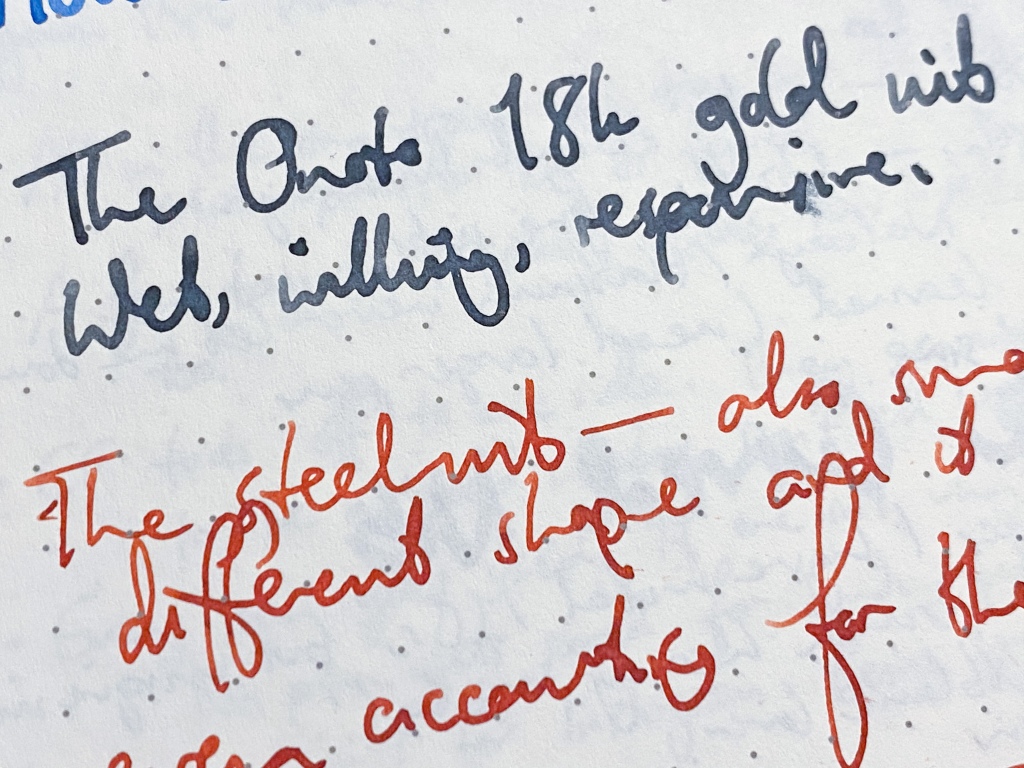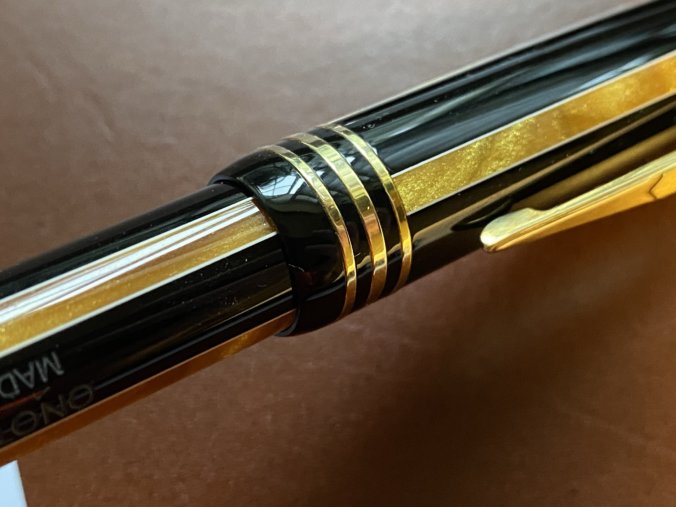A reader recently told me by email that, of all their pens, the Onoto Magna would be the one to accompany them to the proverbial desert island. I cannot possibly disagree with their choice.
If you were to be stuck with just one pen to write page after page, day after day, year after year, I have no doubt that the Magna would be up to the task, and few pens would be more comfortable while you did it.
This is not the first time I’ve reviewed an Onoto Magna. I reviewed one I personally purchased back in March 2019. I then reviewed a version equipped with a plunger filler. And the two pens I’m reviewing here, the Victory and Shakespeare, only reinforce the conclusions I drew in those previous posts. But I do have some new points to add.

What’s unchanged?
Quality control, for a start. I’ve now spent time with five Onotos, four with gold nibs, one with steel, and every one of them has been an utterly perfect writer, with perfect fit and finish, no seams or rough edges. The nibs — including the reversible grind — are a joy, and ready to spring into action at a moment’s notice, with never a worry about drying out when capped.
The ownership experience is uniformly wonderful, with plush packaging, cordial communications, and a real sense of buying into something special when you lift the lid on the wooden box.

The design is noticeably retro and possibly too heritage for some, but the visual identity is also distinctively Onoto and consistent across the range.
The Magna has perfect proportions and balance. It’s a good size, flat-ended, not too long, but broad enough and nestling in your hand rather like a Sailor Pro Gear, with barely-there threads and nary a barrel step in sight.

The materials are unimpeachable, including solid silver cap rings, clip and cap coin, and materials like these pinstripes that you can’t get anywhere else, with optional chasing and that engraved ONOTO THE PEN on the barrel.
The few negatives are also unchanged. The 3+ turns to uncap is a noticeable chore — although in my discussions with Onoto, this is something they can change in their bespoke programme down to perhaps two turns… still not quick, but much much better. And, for sake of completeness, the rear barrel coin is somewhat featureless, although Onoto tells me that some customers choose to have their initials engraved on it.

Finally, the filling mechanism is generic push-fit converter, with the brand’s plunger-filler a £250 upgrade. I am not as dead-set against converters as I used to be, mind you.
So let’s move on to what’s new with these two pens.
Meet the pinstripes
What they have in common is that they’re both limited editions, although unnumbered.
They celebrate famous British cultural icons, Winston Churchill and Shakespeare, and do so through embossed busts on the cap coins, in place of the usual Onoto logo. I actually strongly dislike these cap coins, for a few reasons. First, the portraits, while accurate, are just a little creepy.


The embossing is somewhat faint. Interestingly, the coins on the two pens are of noticeably different thickness, and while the Victory is shiny, the Shakespeare is frosted. Onoto tells me that this is because one was stamped, the other cast by lost- wax.

But most of all I miss the incredible, architectural frosted ONOTO coin that graces the standard Magna.
Instead of usual solid-colour or swirly patterned resin, both the Victory and Shakespeare use pinstripe, which is painstakingly assembled in blanks with dead-straight lines of white separating solid colour from contrasting patterned material. The effect is quite striking, a little flamboyant, and as far as I know, unique.
My personal favourite is the blue pearl stripe on the Victory — the bright golden yellow on the Shakespeare is a bit too bright for me.


To go with the golden pinstripe, the Shakespeare has gold-plated trim. I have to say, I much prefer the raw silver.

The pinstriping really shows off the perfect alignment between cap and barrel that Onoto can achieve. When fully tightened, the stripe is uninterrupted along the full length of the pen.

Unfortunately, you really have to tighten down the cap to make this happen, and I am uncomfortable doing so. So the stripes don’t end up lining up for me in normal use.

The pinstriping also shows up a very uncharacteristic misalignment on the Shakespeare in the barrel engraving, which does not sit evenly between the two stripes. I asked Onoto about this. They said that now they perform all engraving in house, and will ensure perfect alignment.

It’s perfect on the Victory.

Neither pinstripe barrel is chased or filled, unlike my previous two Magnas. It’s nice variety, and I’m not sure which I prefer. A purely cosmetic effect, the lack of chasing doesn’t affect grip in any way.
These are the two lightest Magnas I’ve used: my two previous had respectively a barrel weight inserted and the heavy plunger filler. The lighter weight makes the pens feel that bit more flighty, but not in a bad way. I think on balance the extra weight is worth adding, but your mileage may vary.
Steel or gold?
Most interesting for me was the chance to try Onoto’s steel nib. I opted for the medium, so I had a direct comparison against the gold. I was surprised to see that the shape of the nib and its tines was different, as well as the scrollwork decoration.

On the page, the gold felt softer, smoother, wetter, and wrote a wider line…

… as well as offering more line variation.

But the steel has its own appeal, feeling more precise and crisp, and although it’s not advertised as having a reversible grind as the gold is, the steel too writes a great reverse line. I prefer the gold quite a bit, but at a £150 premium, you may want to think twice and try the steel.
This seems like a good time to talk about pricing. The Shakespeare is an edition of 52 and costs £599. The Victory is an edition of 1874, and costs £549. A gold nib takes those prices to £749 and £699 respectively, which of course is a lot of money.
To look at other premium gold-nibbed, converter pens: an Oldwin Classic in a nice resin with huge nib is around £700. A wooden Cleo Natura or Graf Classic will cost you around £500. A solid-silver Otto Hutt 07 is a competitive £460 at retail. Even a Nakaya Portable Writer with its painstaking Urushi will cost around £700. Only the Yard-o-Led in standard size solid silver weighs in much more than the Onoto, at £890.
Worth the price? Consider it an investment
So, an Onoto is not a cheap pen for what you get, by market standards. But is it worth the premium? A lot of pens have passed through my hands since I first reviewed the Magna. And, 18 months or so on from my first review, I still think it’s a high water mark for serious writing. Few pens are so comfortable, or such good writers.

The pinstripe material is wonderful, a really distinctive aesthetic that I personally like a lot. It comes at a premium, and if you choose the basic Magna at £399 (or £550 with gold nib) you’ll be getting just as good a writing experience — it’s up to you whether the exclusivity is worth the price.
For what it’s worth, I’ve always found Onoto a very friendly company to deal with. It’s a small team based in Norwich. If you have a special request, have a question about the pens, or want to strike a deal — it’s worth dropping them an email to see what they can make happen for you.
Check out the full range of Magnas and other Onoto designs here.
Onoto provided these two pens for review at no charge. I am hanging on to one for long-term comparisons; the other I am returning along with the British Museum pen.

In theory the Magna Classic is too small, too thin and too light for me, yet out of all my pens it is the closest I have to perfection and has resulted in two more Onotos being purchased.
Excellent observation Gary. Should be too small (look at the comparison photo with the Homo Sapiens), but isn’t. Hope you’re enjoying yours!
Splendid review! These striped variants are pretty indeed.
Like dapprman, I loved my first 2 Onotos (1 steel M, 1 gold M which is a little too broad for general writing) so much that I meanwhile ordered a 3rd Onoto. These are perfectly balanced pens, real workhorses with perfect finish, and I find the steel nibs perhaps the best writing steel nibs I came across, together with the steel nib on my Conid. A bit of love and care on the nib before shipping really elevates JoWo and Bock nibs! In general my Onotos write as well as my nicest Montblancs. Only the soft nibs of my Omas are a bit nicer in feel still.
An interesting detail about my 3rd Onoto pen – it is the recent and lovely Loch Ness. It is actually a bit longer than my other 2 Magnas, and looking closer shows that it is all in a slightly longer section. It writes in essence the same. You can notice the longer section on the photos of the Loch Ness pen.
Well I never, now that you mention it the section does look different on the Ness!
I am interested in buying one of the Shakespeare pens they make, but a bit uncertain about a company that also makes pens that honour a criminal such as Churchill.